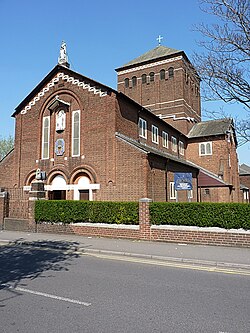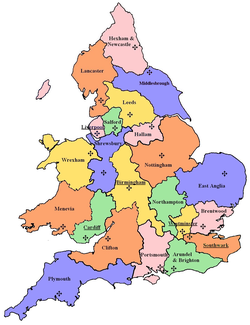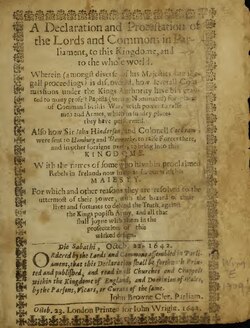
England was a Catholic country until 1534[1]. After this date, Roman Catholics were frequently persecuted and life was made very difficult for them to reside in England and Wales due to a series of legal restrictions. You may find your Catholic ancestor in records of the Church of England. The 1559 Act of Uniformity meant a person could be fined for not attending their local Anglican church meaning you may find your Catholic ancestor attending their local Church of England parish church. Catholic burial grounds were only permitted in England after the Burial Act of 1853, therefore you may find your Catholic ancestor within the Church of England burial registers before this date. These burial entries usually recorded if the deceased was a Catholic. The persecution continued to the point where many Roman Catholic churches did not keep written records until after the Catholic Emancipation Act of 1829. It can therefore be difficult to trace your Catholic ancestors in England.
There are a number of records that a Catholic ancestor may appear in outside of the registers of the Church of England. These include the registers of their own religion, records of confirmation and returns of papists. Catholic records were usually written in Latin until 1965.
Research your ancestors on MyHeritage
Catholic registers of baptisms, marriages and burialsCatholic registers of baptisms, marriages and burials

As previously stated, due to the fear of being uncovered as a Catholic within the country many Catholic churches did not keep written records until 1829. There are earlier examples that have survived however. Catholic chapels were allowed to operate in England and Wales from 1791 after the Catholic Relief Act was introduced, meaning many date back to this time. Registers were held by Catholic priests who travelled between different areas. This led to many registers either being lost or ending up far from where they were created. Catholic dioceses were established in 1850, with Catholic parishes not being established until 1900. Prior to this, the equivalent of a parish in Catholic England was referred to as a mission. Today, the Catholic Church in England and Wales is made up of 22 separate dioceses[2].
Catholic baptism records usually note the date of the event, the child's name and date of birth, their parent's names, the names of the godparents or sponsors of the child, the residence of the family and the name of the officiating priest. Extra information may include the mother's maiden name and if the person being baptised was a converted adult.
Catholic marriage registers should provide the name of the couple, the date and place of the event, the names of the bride and groom's parents, the groom's occupation, the bride and groom's marital status (e.g. if they are widowed) and the witnesses names.
Catholic burial registers usually state the date of the event, the name of the deceased, their residence, their age at death and a grave location. The location is usually the number of a grave plot.
Most Catholic registers are still retained by the chapels themselves. There are a select few which are available to view at The National Archives with some held at local county archives. Many records for Scotland are held at the Scottish Catholic Archives. Some transcripts are available online such as the Shropshire Nonconformist and Roman Catholic Registers collection at MyHeritage. When searching Catholic registers, remember that the Latin form of peoples names was normally used prior to 1965. For example, Benedictus instead of Benedict and Johannes for John.
Further Catholic Church records in the UKFurther Catholic Church records in the UK
- Confirmation- Records of confirmation usually give a person’s name, age and residence along with the name of the bishop who oversaw the event.
- Benefactors- Lists of those who donated to the Catholic church or left money for them after their death will include their name and the amount that they donated. Their date of death may also be recorded if relevant.
- Church diaries- Handwritten Catholic church diaries vary in their content but may include dates of death of the congregation, names of those who spoke during mass, the announcement of any marriage banns and any other notable upcoming dates within the church.
- Confessions- Lists were taken of those attending confession. No details are normally given other than the person's name and the date that they attended. If the list refers to children, it may note if they have been baptised in the Catholic church.
Other records of Catholics in the UKOther records of Catholics in the UK

- Returns of Papists- British authorities liked to keep track of how many Catholics they were residing in the country and where they lived. As a result, audits were taken where Catholics were counted, although unfortunately for researchers their names were not taken. Audits were taken in 1680, 1705, 1744, 1767 and 1780. These may be found in The National Archives or in Quarter Sessions records at county archives.
- Recusant Rolls- The rolls contain the names of those who refused to conform to the Anglican doctrine dating from 1592-1691. Most are held at The National Archives.
- Protestation Oath Returns- All adult males were required to take on oath of loyalty to the Protestant faith in 1641-1642. This was done in order to seek out Catholics within the country. If anybody refused to take the oath, their names were usually recorded along with whether they were Catholic or if there was another reason they could not take it (e.g. illness).
Explore more about Catholic Church records in the United KingdomExplore more about Catholic Church records in the United Kingdom
- Shropshire Nonconformist and Roman Catholic Registers record collection at MyHeritage
- Catholic Record Society Miscellanea IV record collection at MyHeritage
- Catholic Record Society, Miscellanea, Volume 7 record collection at MyHeritage
- Haydock Papers: a Glimpse Into English Catholic Life Under the Shade of Persecution And in the Dawn of Freedom record collection at MyHeritage
- Finding Your Roots in Catholic Records webinar at Legacy Family Tree Webinars
References
- ↑ https://www.nationalarchives.gov.uk/help-with-your-research/research-guides/catholics/The National Archives. Retrieved 5th November 2024
- ↑ https://www.cbcew.org.uk/diocese/ Catholic Bishops' Conference of England and Wales. Retrieved 5th November 2024

